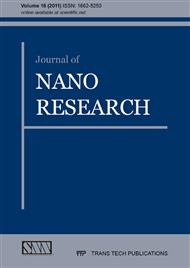p.1
p.9
p.15
p.21
p.29
p.37
p.43
p.49
Synthesis and Characterization of ZnO-SiO2/Epoxy Nanocomposite Coating by Sol-Gel Process
Abstract:
In this paper, we report preparation of hydrophilic hybrid nanocomposite coatings on glass substrates using Zinc acetate solutions based on 3-glycidoxypropyltrimethoxysilane (GPTMS), epoxy resin, aromatic amine (HY850), polyethylene glycol (PEG) and surfactant (polyoxyethylene(4)laurylether) by the sol-gel process. Furthermore, the effects of PEG addition to the precursor solutions on the hydrophilic property and microstructure of the resultant coating film were studied. The hydrophilic behavior study of the synthesized hybrid was performed by adding different amounts of polyethylene glycol precursor to the hybrid solution. Experimental results show that, among different amounts of PEGs, the best results are obtained by addition of PEGs (400) to the hybrid solution which can decrease the water contact angles down to 16 and using surfactant down to 0, and increase the free surface energy. Coated glass exhibits a higher strength than uncoated glass. Attenuated total reflectance infrared spectroscopic (ATR-IR) technique was used to characterize the structure of the hybrid films. The chemical structure of obtained network affects morphology of the coating. The morphology of the hybrid coatings was examined by transmission electron microscopy (TEM). The hybrid systems have a unit form structure and the inorganic phases were in the nanosize scale,
Info:
Periodical:
Pages:
1-7
Citation:
Online since:
January 2012
Authors:
Keywords:
Price:
Сopyright:
© 2011 Trans Tech Publications Ltd. All Rights Reserved
Share:
Citation:


